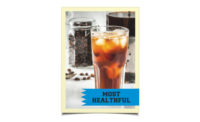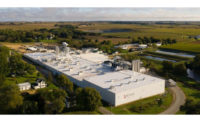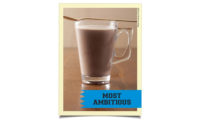We dusted off the jukebox to play the songs that best represent dairy foods and beverages. Our annual State of the Dairy Industry report examines the prospects for all dairy categories. For the nondairy beverages category the tune is ‘Wake Me Up Before You Go-Go,’ as jolt of caffeine wakes up beverage sales.
Consumers continue to show an interest in good-for-you beverages. Processors of nondairy beverages tell us that shoppers seek less sugar and unsweetened or zero-calorie beverages.
“A rise in health concerns, proactive health management, as well as evolving demographics are all driving changes in the food/beverage landscape,” said Sara Loveday of The WhiteWave Foods Co., a maker of dairy and nondairy beverages. “We continue to see a rise in baby boomers who are looking for healthy alternatives; growth of the Hispanic population, of which 51% are lactose-intolerant; and a large Millennial population that grew up with milk alternative offerings as part of their household consumption.”
“Consumers are seeking variety and healthier refreshment. And the performance in the market reflects this,” added Gary Hemphill, managing director of research at New York-based Beverage Marketing Corp.
Nondairy processors told us how they are meeting these consumer demands with their new products.
Double-digit gains for iced coffee
According to IRI, sales in the cappuccino/iced coffee category jumped 10.7% to $1.3 billion. Not surprisingly, five dairy- and nondairy-based Starbucks SKUs held the top five spots (see table on page 80).
Black Medicine from Oakland, Calif., is a new line of iced coffees that launched in January. Packaged in an 11-ounce bottle, Black Medicine Iced Coffee includes no artificial ingredients and has a recommended eight-week shelf life.
“The RTD iced coffee market is gaining momentum fast,” said Chris Bukowinski, manager, “thus our greatest opportunity is getting more exposure in the market while this category continues to grow.”
Also getting into the cold coffee trend is So Delicious Dairy Free with its Cococcino beverages that debuted in March. Available in two flavors — latte and mocha — and in two sizes (32-ounce quarts or 11-ounce single-servings) all packaging is resealable and recyclable. The beverages are USDA-certified organic and made with fair trade coffee. Two new almond milk coffee creamers, in original and French vanilla, also debuted this year. In September, WhiteWave said it is acquiring Eugene, Ore.-based So Delicious.
“We feel strongly that dairy-free has tremendous growth potential. Our fans have come to us for many reasons. Some find us because they have food allergies or intolerances in their household. Others have gone dairy-free for health reasons or to manage weight loss. Others are interested in supporting animal welfare or the environment and dairy-free is considerably kinder to animals and the planet,” said Hilary Martin, So Delicious spokesperson.
Almond yes, soy no
“In dairy alternatives, almond milk has been the star performer,” said Hemphill, “while soy has lagged somewhat. We expect this trend will continue.”
Blue Diamond Growers led the ready-to-drink almond milk category (see table on page 82) and it continues to capitalize on consumers’ preference for almond milk with several new introductions. The almond cooperative expanded the 64-ounce refrigerated Almond Breeze line with two reduced-sugar options, original and vanilla. Almond Breeze Hint of Honey in both vanilla and original debuted in 64-ounce refrigerated offerings in May followed in June by 32-ounce shelf-stable offerings.
WhiteWave Foods’ Silk brand also expanded its almond milk offerings. Silk Almondmilk Protein + Fiber and Silk Almond Coconut Blend were both launched this year. “We have definitely embraced the trend of consumers wanting products that provide enjoyment ‘and’ added nutrition,” said Loveday. Per serving, Silk Almondmilk Protein + Fiber offers 5 grams of protein, 5 grams of fiber and 50% more calcium than dairy milk.
Loveday noted that top barriers to the category include taste, not being top of mind, or not understanding the nutritional advantages, “which we’re addressing through sampling/couponing, awareness building and education efforts.”
Sales in the ready-to-drink soy milk category dropped 22.4% in the latest 52 weeks (see table). Every brand in the top 10 registered declines in dollar and unit sales.
New ideas in energy, functional drinks
IRI reported the energy drink category grew 5.3% to $10.8 billion in the 52 weeks ended Aug. 10, 2014. Certain segments performed better than others. In the largest segment — shelf-stable non-aseptic drinks — sales rose 6.8% to $9.1 billion in the period. Sales declined in the aseptic, energy shot and drink mix segments.
The Coca-Cola Co.’s VitaminWater, New York City, made its way into the energy category with three flavors of vitaminwater energy: strawberry-lime, berry-punch and orange-mango. A raspberry-citrus flavor is available only at 7-Eleven stores. The lightly carbonated drink gets its boost from green coffee bean extract. Each 11.5 fluid-ounce can contains 80 milligrams of caffeine and 50 calories. Suggested retail is $2.29.
Paradise Beverage, Austin, Texas, also made its way into the category with Pirate Energy Shots, a mix of amino acids and natural metabolites. Focusing on consumers looking for a pep to party, the nonalcoholic shots are available in five cocktail-inspired flavors: margarita, mojito, pina colada, hurricane and pirate punch. Each 1.7-ounce bottle contains 133 milligrams of caffeine.
Oxnard, Calif.-based KeVita expanded its presence in the functional beverage category this year with three new flavor additions to its line of sparkling probiotic drinks: hibiscus berry, tangerine and blueberry cherry. Each of the new flavors has no added sugar and is certified organic, non-GMO, gluten-free, vegan and is enhanced with magnesium.
“At the core of all KeVita products is a proprietary blend of four strains of live, complementary probiotics,” said Bill Lange, VP of marketing, “plus a signature KeVita culture.”
And in October, KeVita Master Brew Kombucha launched in six flavors: ginger, grapefruit, pineapple peach, tart cherry, raspberry lemon and lavender melon.
“This is the first line extension for us and enables the team to apply their wide-ranging functional beverage knowledge and probiotic expertise to this popular fermented tea category,” added Lange, who said that compared to the leading market brand, KeVita’s kombucha offers twice the amount of probiotic culture, 33% fewer calories and five times the organic acids. To play up the kombucha’s bolder flavors, labeling and branding has a more handcrafted, gender-neutral style in an effort to particularly attract males.
Flavors help coconut water
Bottled water continues its strong growth, especially in the single-serve segment. “Its healthy positioning and aggressive pricing have helped to propel category growth,” said Hemphill.
Coconut water also continues to experience solid growth and as Hemphill said is “positioned as nature’s sports drink.” While he added that it’s a viable category, he pointed out the high price and unique flavor profile may limit growth to some extent.
To capitalize on its popularity, some manufacturers have rolled out flavored coconut waters. Blue Marble Brands added three flavors to its Harvest Bay line of all-natural coconut water: pineapple, orange mango and pomegranate. Each is packaged as individual 8.4 fluid-ounce aseptic units and has 45 calories and 7 grams or less of sugar. The brand also offers organic coconut waters in original, dark chocolate and iced coffee. All of the brand’s coconut waters are non-GMO project verified.
El Segundo, Calif.-based Zico Beverages, maker of Zico Premium Coconut Water, has juice blends. The chilled juices (orange juice and pineapple-mango-orange) have no added flavors or preservatives. Each has 60 calories per 8-ounce serving and is sold in 1.5-liter aseptic cartons for $7.99.
Nestlé Pure Life, Stamford, Conn., also turned to flavors, expanding its product portfolio with the launch of Exotics Sparkling Water, a line of unsweetened sparkling water with all-natural fruit flavors, that the company said has “carbonation levels similar to canned soda.” The zero-calorie beverages, made with no artificial colors or sweeteners, are available in mango peach pineapple, strawberry dragon fruit, tangerine and key lime. Suggested retail price is $2.99 for an eight-pack carton of 12-ounce cans.
Drinking better juice
“The overall market for fruit beverages has struggled in recent years, but there has been growth in the super-premium segment of the category,” said Hemphill.
Naked Juice Co., owned by Purchase, N.Y.-based PepsiCo Inc., added four varieties this fall: kale blazer, protein & greens, chia sweet peach and chia cherry lime. All are packaged in 15.2-ounce bottles.
Honest Tea, Bethesda, Md., debuted a limited-edition line of organic Summer Refreshers nationwide at Whole Foods in May. Available only for the summer, flavors included berry hibiscus lemonade, original lemonade, mango lemonade, mint limeade and half and half lemonade and tea. Available in a 32-ounce glass bottle, all are sweetened using organic, fair trade certified sugar.
Bolthouse Farms, Bakersfield, Calif., is also hoping to gain traction with children and their parents. The unit of Campbell Soup Co. launched a new line of dairy-free fruit purees called Fruit Tubes. They are part of a new child-oriented snack line that includes nondairy smoothies (made with coconut water) and packaged raw vegetables sold in grocers’ produce sections. The 2-ounce tubes can be eaten out of the fridge or freezer. The flavors are mango-banana-pineapple, strawberry-banana and blueberry-raspberry. The smoothie flavors are strawberry-banana and peach-mango.
The boom in iced coffee should be considered a wake-up call for dairies. The caffeinated drinks made with milk just might give milk processors the jolt they sorely need.
Tweet this, like that
Marketers of nondairy beverages are using social media channels, nontraditional advertising media and partnerships to promote their products.
For example, when Zico embarked on a multimillion-dollar brand campaign, it hired actress Jessica Alba as brand ambassador. Zico’s Crack Life Open campaign included print, out-of-home and digital advertising. The promotion reminds consumers to live positively by taking small steps to treat themselves well every day. The hashtag #CrackLifeOpen is being used in blogger programs and fan contests. Zico is also present at triathlons in Malibu, Calif., and New York City.
This summer, Honest Tea entered into an agreement with national theater chain Cinemark to make two of its five Honest Kids organic juice drink flavors available in more than 300 cinemas nationwide.
Almond Breeze uses social media to “interact with our brand loyalists with the goal of encouraging them to become brand advocates,” said Suzanne Hagener, group marketing manager. “We have a very active presence on Facebook, Twitter and Pinterest, in addition to a robust set of food bloggers that we work with that help us show the different ways that Almond Breeze can be incorporated into recipes and smoothies.”
And then there is Oprah. Oprah Winfrey brought her celebrity status to the tea category this year when she launched Teavana Oprah Chai Tea. Sold in Starbucks and Teavana stores across the United States and Canada, Starbucks (which owns Teavana) makes a donation for each product sold to the Oprah Winfrey Leadership Academy Foundation. The nonprofit supports educational opportunities for youth. Along with the launch of the tea, a new website was created — www.steepyoursoul.com — to feature videos, articles and a “behind-the-scenes” look at how Oprah steeps her soul.









